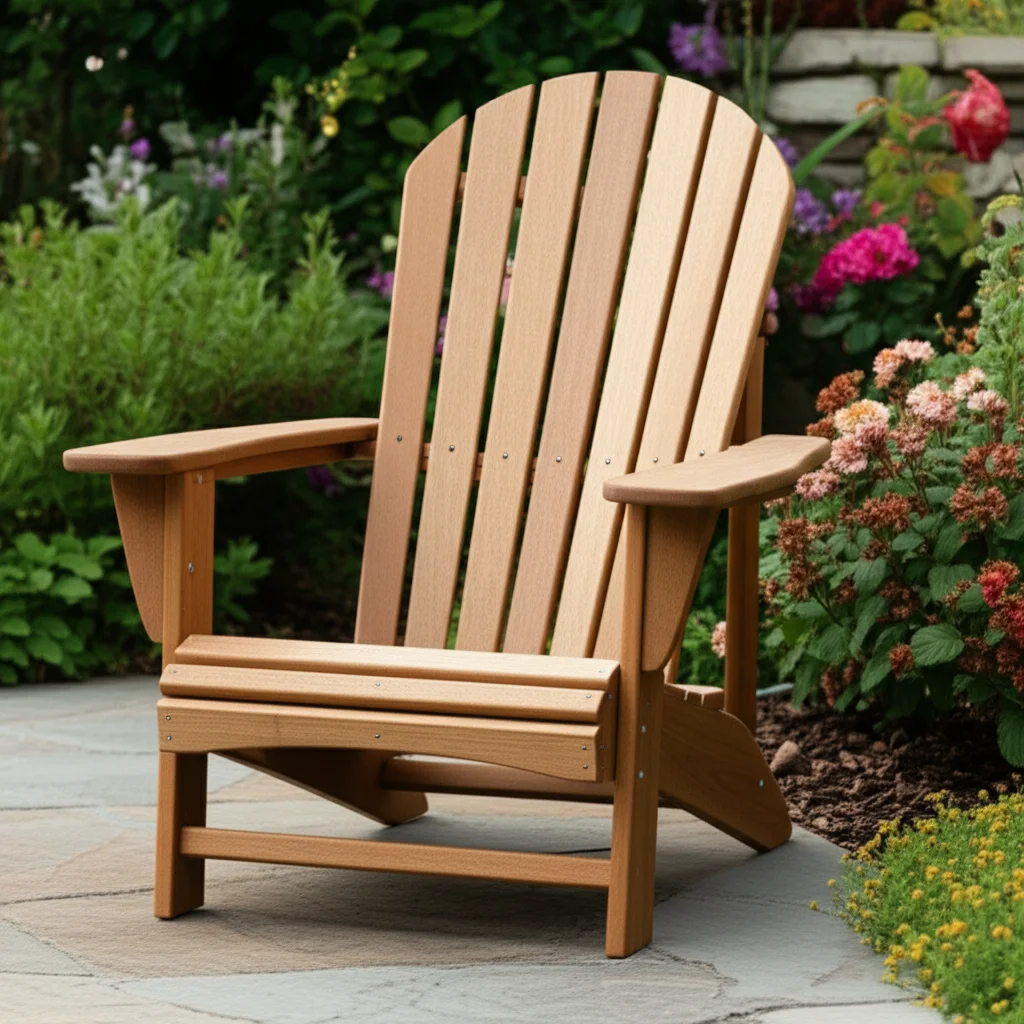· Todd Martin · Outdoor Furniture Care · 18 min read
How To Clean Polywood

How to Clean Polywood Furniture for Lasting Beauty
Imagine relaxing on your patio, surrounded by beautiful, pristine outdoor furniture. Polywood furniture brings this vision to life with its incredible durability and resistance to the elements. Yet, even this robust material benefits from regular cleaning to maintain its attractive appearance. Learning how to clean Polywood properly keeps it looking new for years.
This guide helps you understand the best ways to care for your Polywood pieces. We will explore essential tools, simple routine cleaning, and effective deep cleaning methods. You will also discover how to tackle stubborn stains and special care for white Polywood. Finally, we will cover preventative measures and common mistakes to avoid. My aim is to make Polywood cleaning easy and effective for you.
Takeaway
Keeping your Polywood furniture pristine involves simple steps:
- Regular Cleaning: Use warm water and mild soap for routine dirt.
- Deep Cleaning: Tackle stubborn grime with a soft brush and a stronger cleaner like a bleach solution.
- Stain Removal: Address specific stains promptly with appropriate household products.
- Protect: Rinse thoroughly after cleaning and consider protective measures.
- Avoid: Harsh abrasives or strong solvents not recommended for Polywood.
To clean Polywood, simply wash it with warm, soapy water and a soft-bristle brush, then rinse thoroughly. For stubborn dirt or mildew, a diluted bleach solution (1/3 cup bleach to 1 gallon of water) can be used, followed by a good rinse. Regular cleaning prevents buildup and maintains its appearance.
Discovering Polywood: An Introduction to Its Unique Nature
Polywood furniture has become a favorite for outdoor spaces, and for good reason. This material is made from recycled plastic, primarily milk jugs and detergent bottles. Manufacturers transform these plastics into durable lumber. This process creates a material that looks like wood but performs much better outdoors.
Polywood resists common outdoor problems. It does not rot, crack, or splinter, unlike traditional wood. You also do not need to paint, stain, or waterproof it. This makes Polywood a low-maintenance choice for patios, decks, and gardens. Its color runs throughout the material, which means scratches are less visible. This inherent durability makes it an excellent investment for any outdoor setting.
Despite its resilience, Polywood furniture still benefits from proper care. Over time, outdoor elements like dirt, pollen, tree sap, and environmental pollutants can build up. Mildew can also form in damp conditions, especially on lighter colors. Regular cleaning prevents this buildup from becoming permanent. It helps your furniture retain its vibrant color and smooth texture. Knowing how to clean Polywood ensures you enjoy its beauty for many seasons.
Understanding the material helps you clean it correctly. Polywood is non-porous, which means it resists absorption of liquids and stains. This characteristic makes cleaning relatively straightforward. However, it also means that dirt and grime sit on the surface. We can easily wipe or brush away most common outdoor messes. Using the right techniques and cleaning solutions protects its finish and extends its life.
My experience shows that a little preventative care goes a long way. Keeping Polywood clean prevents deeper issues from forming. Think of it as protecting your investment. Simple steps today save you effort tomorrow.
Essential Tools and Supplies for Cleaning Polywood Furniture
Having the right tools makes cleaning Polywood easy and effective. You do not need many specialized items. Most of the supplies are common household goods. Gathering them before you start saves time and effort. I always prepare my cleaning station first.
First, you will need a soft-bristle brush or a non-abrasive sponge. These tools are gentle on the Polywood surface but effective at scrubbing away dirt. Avoid abrasive scrubbers or steel wool, as these can scratch the material. A garden hose with a spray nozzle is also essential for rinsing. A strong spray helps remove loose debris and cleaning solutions.
For cleaning solutions, a mild dish soap is a primary choice for routine cleaning. Mix a small amount with warm water in a bucket. This creates a gentle yet effective cleaning mixture. For tougher jobs, like mildew or stubborn grime, you might need something stronger. A solution of 1/3 cup of laundry bleach to 1 gallon of water is often recommended. This specific ratio helps remove mildew without harming the Polywood. Always test any strong solution in an inconspicuous area first.
For very specific stains, you might need a few extra items. A Mr. Clean Magic Eraser can work wonders on scuff marks or light discoloration. Isopropyl alcohol can address grease or oil spots. For tree sap, mineral spirits can be effective. Always use these specialty cleaners sparingly and rinse thoroughly afterward. Remember, the goal is to clean without damaging the surface.
Finally, prepare some clean cloths or towels. These are useful for wiping down surfaces or drying areas if desired. While Polywood dries quickly, a quick wipe can prevent water spots. Having these basic supplies on hand ensures you are ready for any cleaning task. My philosophy is simple: equip yourself well, and the task becomes much simpler.
- Soft-bristle brush or non-abrasive sponge: For scrubbing without scratching.
- Garden hose with spray nozzle: For effective rinsing.
- Bucket: To mix cleaning solutions.
- Mild dish soap: For routine cleaning.
- Laundry bleach: For mildew or stubborn stains (diluted).
- Mr. Clean Magic Eraser: For scuff marks.
- Isopropyl alcohol: For grease or oil stains.
- Mineral spirits: For tree sap.
- Clean cloths or towels: For wiping and drying.
Routine Cleaning: Keeping Your Polywood Fresh and Pristine
Regular maintenance keeps your Polywood furniture looking its best year-round. This basic cleaning routine is quick and simple. It prevents dirt and grime from building up, which makes deeper cleaning less frequent. I perform this routine monthly, or more often if the furniture sees heavy use or bad weather.
Start by removing any loose debris from the furniture. Use a soft brush or simply wipe off leaves, pollen, or dust. A dry cloth can work well for this first step. This prevents scratching the surface when you introduce water. It also helps the cleaning solution work more effectively on the stuck-on dirt.
Next, prepare your cleaning solution. Mix a small amount of mild dish soap with warm water in a bucket. A few squirts of soap are usually enough for a gallon of water. You want a soapy solution, not excessive suds. This gentle mixture lifts everyday dirt without harming the Polywood.
Now, apply the soapy water to the furniture. Use your soft-bristle brush or non-abrasive sponge. Dip the brush into the solution and gently scrub the surfaces. Work in small sections to ensure thorough cleaning. Pay attention to crevices where dirt might accumulate. The key is gentle but firm scrubbing to loosen the grime. My goal here is to remove surface dirt, not to deep clean.
After scrubbing, rinse the furniture thoroughly with a garden hose. Ensure all soap residue is gone. Any leftover soap can attract new dirt and leave a dull film. A good rinse also helps to prevent water spots, especially in direct sunlight. Allow the furniture to air dry completely. Polywood dries quickly, making this step effortless. This routine cleaning keeps your outdoor space inviting and clean.
This simple process is often enough for well-maintained Polywood. If you follow these steps regularly, your furniture will maintain its vibrant look with minimal effort. Consistent care is the secret to enduring beauty.
Deep Cleaning Polywood: Conquering Stubborn Grime and Mildew
Sometimes, routine cleaning is not enough. Stubborn grime, mold, or mildew can accumulate, especially in humid environments. When your Polywood furniture needs a more intense cleaning session, a deep clean is in order. This process effectively removes tough buildup and restores its appearance. I tackle these deeper cleanings seasonally or as needed.
Before you begin deep cleaning, remove all cushions and accessories. Rinse the furniture with a garden hose to remove loose dirt and prepare the surface. This pre-rinse allows your deep cleaning solution to work directly on the embedded grime. It also prevents dirt from scratching the surface during scrubbing.
For serious grime or mildew, I recommend a diluted bleach solution. Mix 1/3 cup of liquid laundry bleach with 1 gallon of water. Always wear gloves and eye protection when working with bleach. Apply this solution to the Polywood surface using a soft-bristle brush. Scrub vigorously, focusing on areas with visible mildew or heavy dirt. The bleach works to break down the organic matter. For mold issues, consider reviewing how to clean mold with vinegar, as vinegar offers an alternative, less harsh approach to mold remediation on various surfaces. While the bleach solution is effective for Polywood, understanding other methods for mold can be useful for other household items.
For deeply embedded dirt that isn’t mold or mildew, you can also use a mixture of warm water and a small amount of dish soap, but with more elbow grease. A pressure washer can be an option for stubborn areas, but use it with extreme caution. Set the pressure to a low setting (1,500 psi or less) and keep the nozzle at least 12 inches away from the surface. A fan tip is preferable over a pinpoint nozzle. High pressure too close can damage the material, specifically the wood grain texture. For cleaning large outdoor surfaces like siding, pressure washing is a common and effective method, and some of the principles regarding nozzle distance and pressure can apply to Polywood. You can learn more about general pressure washing techniques from guides on how to clean siding. Always test a small, hidden area first if using a pressure washer.
After scrubbing with your chosen solution, rinse the furniture immediately and thoroughly with fresh water from your garden hose. Ensure all the cleaning solution is completely washed away. Bleach left on the surface can degrade the material over time, even Polywood. Allow the furniture to air dry fully. This deep cleaning method brings back the original luster of your Polywood furniture. Your outdoor space will look refreshed and inviting after this thorough clean.
Targeted Stain Removal: How to Handle Specific Polywood Blemishes
Even with regular cleaning, specific stains can sometimes appear on Polywood furniture. Different types of stains require different approaches for effective removal. Acting quickly is key to preventing stains from setting in. I find that identifying the stain type helps me choose the right cleaner.
For scuff marks or light discoloration, a Mr. Clean Magic Eraser often works wonders. Dampen the eraser and gently rub the affected area. The micro-abrasive nature of the eraser helps lift surface marks without damaging the Polywood. Always test it on an inconspicuous spot first to ensure compatibility, though it is generally safe.
Grease and oil stains can occur from food spills or outdoor equipment. For these, a solution of warm water and a few drops of dish soap can be effective. Apply it directly to the stain, let it sit for a few minutes, then scrub with a soft brush. If the stain persists, a small amount of isopropyl alcohol on a cloth can help break down the grease. Wipe it on, then rinse immediately. For general stain removal techniques, you might find similarities in methods used for other surfaces like walls; consider exploring tips on how to clean stains off walls for broader insights.
Tree sap is another common outdoor culprit. This sticky substance can be challenging. I recommend using mineral spirits applied to a soft cloth. Gently dab the sap until it softens and can be wiped away. Follow up with a mild soap and water wash, and then a thorough rinse. Always ensure good ventilation when using mineral spirits.
Food and beverage stains, such as coffee, wine, or juice, usually come off with warm soapy water and a brush. If the stain is dried, let the soapy water soak on the area for a few minutes to rehydrate it. Then scrub and rinse. For general cleaning with vinegar, which can tackle many light organic stains, you can also refer to techniques for other household items like how to clean a shower with vinegar.
Always rinse the area thoroughly after treating any stain with a specialized cleaner. This removes all chemical residues. Letting cleaners dry on the surface can leave a film or cause new issues. Prompt action and the right cleaner ensure your Polywood remains spotless.
Special Care for White Polywood: Maintaining Brightness
White Polywood furniture offers a crisp, clean aesthetic, but it can show dirt and environmental buildup more readily than darker colors. Maintaining its bright, pristine appearance requires a little extra attention. The good news is that Polywood’s non-porous nature makes it relatively easy to keep white. I often get asked about the best way to keep white Polywood looking new.
Regular cleaning is even more crucial for white Polywood. Dust, pollen, and everyday grime are more visible against a white background. Follow the routine cleaning steps with mild soap and water frequently. This prevents contaminants from settling into the surface and causing discoloration. My rule is, if it looks a little dull, it’s time for a wash.
For more persistent discoloration or mildew, which can appear as black spots or green patches, a diluted bleach solution is highly effective. As mentioned earlier, mix 1/3 cup of liquid laundry bleach with 1 gallon of water. Apply this solution with a soft-bristle brush, scrubbing gently but thoroughly over the affected areas. The bleach helps to sanitize and restore the white color. Be sure to rinse very thoroughly after using bleach to remove all traces. For a deeper dive into maintaining the bright look of your white Polywood furniture, I recommend reading our comprehensive guide on how to clean white Polywood furniture. This resource provides specific tips for keeping those lighter shades sparkling.
Another common issue for white Polywood is scuff marks from shoes or other items. A Mr. Clean Magic Eraser is an excellent tool for these. Gently rub the scuff mark with a damp Magic Eraser. It works by slightly abrading the surface, lifting the mark away. Again, always test on a hidden area first.
Avoid certain products on white Polywood that could cause yellowing or permanent staining. Do not use abrasive cleaners or scouring pads, as these can scratch the surface, making it harder to clean in the future. Also, be wary of colored cleaning cloths that might transfer dye, especially if the Polywood is wet. Use white or light-colored cloths instead.
With consistent care, your white Polywood furniture will remain a stunning feature of your outdoor space. It is a commitment that pays off in enduring beauty.
Protecting Your Polywood: Preventative Measures and Long-Term Care
Cleaning Polywood furniture is important, but preventing dirt and damage in the first place is even better. Implementing preventative measures can significantly reduce how often you need to perform deep cleaning. Long-term care ensures your investment lasts for decades. I believe prevention is the best approach to maintaining outdoor furniture.
One simple preventative step is regular rinsing. After a dusty day or heavy rain, a quick spray with a garden hose can wash away loose dirt and pollen. This prevents these particles from sticking to the surface. It also helps remove airborne pollutants before they can cause buildup. Make this a habit, especially during pollen season.
Consider placing your Polywood furniture under a covered patio or awning if possible. This protects it from direct sunlight, heavy rain, and falling debris like leaves or sap. While Polywood is UV-stabilized and weather-resistant, reducing exposure can further extend its lifespan and maintain its color. If you don’t have a cover, consider using furniture covers during off-seasons or extended periods of non-use. These covers shield the furniture from harsh elements and keep it cleaner.
Periodically inspect your furniture for any minor issues. Check for loose screws or fasteners and tighten them as needed. While Polywood does not absorb water, moisture can sometimes get into the fasteners, leading to minor corrosion over many years. A quick check can prevent bigger problems. This vigilance helps maintain the structural integrity.
Some manufacturers offer Polywood-specific cleaners or protective sprays. While not strictly necessary, these products can sometimes offer an extra layer of protection or enhance the material’s appearance. Always follow the product instructions carefully. Before applying any new product, test it on a small, hidden area to ensure it does not cause discoloration or damage.
Proper storage during winter or prolonged periods of non-use is also beneficial. If you live in an area with harsh winters, storing your furniture in a garage or shed keeps it protected from snow and ice. Even if left outdoors, covers provide excellent protection. These long-term care strategies ensure your Polywood furniture remains beautiful and functional for many years to come.
Common Polywood Cleaning Mistakes to Avoid
While cleaning Polywood is straightforward, it is easy to make mistakes that can diminish its appearance or even damage the material. Knowing what to avoid is as important as knowing what to do. I have seen common errors that lead to frustration.
One common mistake is using abrasive cleaners or scrubbing pads. Products like steel wool, harsh scouring powders, or even overly stiff brushes can scratch the Polywood surface. These scratches create microscopic grooves where dirt and grime can collect, making future cleaning more difficult. Always opt for soft-bristle brushes, non-abrasive sponges, or cloths. Your goal is to clean gently, not to sand.
Another error is using strong chemical solvents. While Polywood is resistant to many elements, certain chemicals can cause damage or discoloration. Avoid cleaners containing acetone, ammonia (in high concentrations), or strong degreasers not specifically designed for plastics. These chemicals can break down the plastic polymers or cause fading. Always stick to mild soap and water, or a diluted bleach solution as recommended. If you’re cleaning other plastic surfaces, such as a plastic shower, similar cautions about harsh chemicals apply.
Leaving cleaning solutions to dry on the furniture is another mistake. Whether it is soapy water or a bleach solution, always rinse the furniture thoroughly after scrubbing. Dried soap residue can leave a dull, streaky film. Dried bleach can potentially degrade the material over a long period or leave white spots. A complete rinse ensures a clean, residue-free finish.
Using a pressure washer improperly can also cause problems. While a low-pressure setting can be useful for deep cleaning, too high a pressure or holding the nozzle too close can damage the surface texture of the Polywood. It can etch the material or even chip away at the finish. Always use a wide fan tip, keep a safe distance, and use the lowest effective pressure. When in doubt, stick to manual scrubbing.
Finally, neglecting regular cleaning is a common oversight. Allowing dirt, mildew, and stains to accumulate over long periods makes them much harder to remove. What could have been a quick rinse and wipe becomes a laborious deep cleaning project. Consistent, gentle cleaning prevents major issues. Avoid these common pitfalls to keep your Polywood furniture in top condition with minimal effort.
FAQ Section
Q1: Can I pressure wash Polywood furniture? A1: Yes, you can pressure wash Polywood, but with caution. Use a low-pressure setting (1,500 psi or less) and keep the nozzle at least 12 inches away from the surface. Use a fan tip, not a pinpoint stream. High pressure can damage the material’s texture. Always test a small, inconspicuous area first to ensure it does not cause etching or streaking.
Q2: What should I avoid using to clean Polywood? A2: Avoid abrasive cleaners like steel wool, scouring pads, or harsh bristle brushes, as these can scratch the surface. Also, do not use strong chemical solvents such as acetone, ammonia, or certain degreasers not specifically designed for plastics, as they can cause damage or discoloration. Stick to mild soap, water, and diluted bleach.
Q3: How often should I clean my Polywood furniture? A3: For routine maintenance, aim to clean your Polywood furniture monthly or every few weeks, especially during peak outdoor seasons. This prevents dirt and pollen buildup. A deeper clean, addressing mildew or stubborn stains, might be needed seasonally or once or twice a year, depending on your climate and use.
Q4: Does Polywood fade or stain easily? A4: Polywood is designed to be highly resistant to fading and staining. It contains UV inhibitors to prevent color degradation from sun exposure. Its non-porous surface also repels most stains, making them easy to wipe away if addressed promptly. Darker colors might show less dirt, but even white Polywood maintains its brightness with proper care.
Q5: Can Polywood furniture get mold or mildew? A5: While Polywood itself does not support mold growth, mold and mildew can grow on the surface, feeding on accumulated dirt, pollen, or other organic matter. This is particularly common in humid environments. A solution of 1/3 cup bleach to 1 gallon of water is highly effective for removing mold and mildew from the Polywood surface.
Q6: Are there special Polywood cleaners available? A6: Yes, some manufacturers offer specialized Polywood cleaning products designed for their furniture. These can be effective, but often a simple solution of warm water and mild dish soap is sufficient for routine cleaning. For tougher jobs, a diluted bleach solution is a widely recommended and cost-effective option.
Conclusion
Polywood furniture offers an ideal blend of beauty, durability, and low maintenance for any outdoor space. While it stands strong against the elements, a little care goes a long way in preserving its appeal. Learning how to clean Polywood effectively ensures your investment remains vibrant and inviting for many years. From routine washes to tackling tough stains, the process is straightforward and rewarding.
We covered the importance of consistent cleaning, gathering the right tools, and executing both basic and deep cleaning methods. You now understand how to handle specific stains and provide special care for white Polywood. Moreover, we discussed preventative measures and crucial mistakes to avoid, empowering you to protect your furniture. By following these simple guidelines, you will keep your Polywood looking as good as new. Embrace these tips and enjoy your pristine outdoor living space. Your Polywood furniture is built to last, and with proper cleaning, it will continue to enhance your home for decades.
- Polywood cleaning
- Outdoor furniture care
- Composite furniture cleaning
- Eco-friendly cleaning
- Outdoor living maintenance
- Patio furniture



